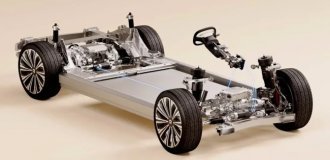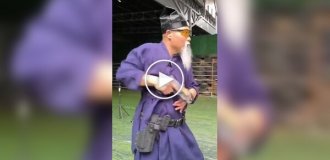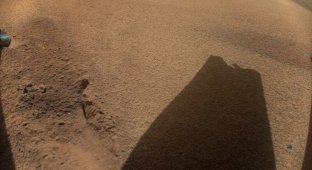The unmanned robotic vehicle Ingenuity (Ingenuity) was the first aircraft to conquer Mars.
It was the helicopter that made the first controlled flight over the surface of another planet. 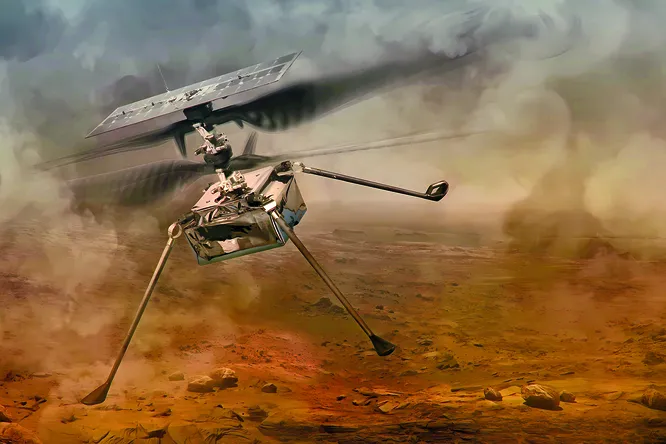
The first problem in developing such a helicopter was the thinness of the Martian atmosphere. Its pressure at the surface is 160 times less than that on Earth – this is observed in our country at approximately 30 km altitude. However, for the operation of the screw it is not so much the pressure that is important as the density of the working medium. On the Red Planet it is about 20 g/m3 - 61 times less than at the surface of the Earth (1225 g/m3). Staying in such an environment is not at all the same as taking off normally.
To obtain the same lift force in the rarefied air of the Red Planet as at the surface of the Earth, it is necessary to increase the speed of gas flow around the blades by 7.8 times (the square root of 61) - in other words, the propeller must rotate the same number of times faster. However, the figure may decrease, since the resistance of the Martian atmosphere is lower, and gravity there is 62% weaker than ours. 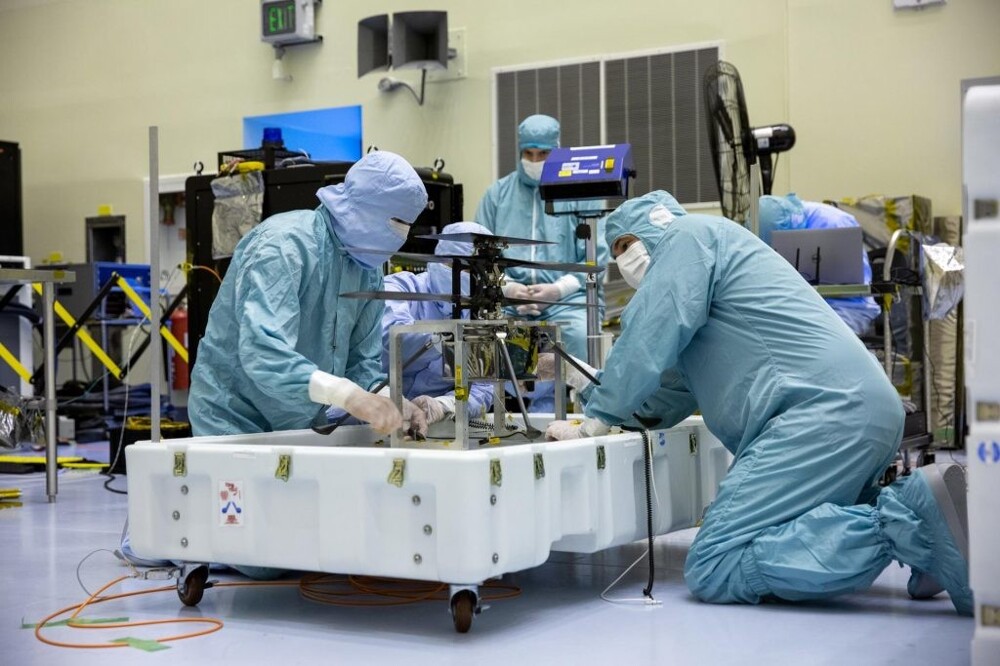
To create the aerodynamic force required at such an altitude, the propellers must rotate many times faster than usual - so much so that their tips will move at supersonic speeds.
Rapid rotation in a rarefied atmosphere gives rise to new problems, including the famous Dzhanibekov effect. To compensate for this force, counterweights had to be added to the Ingenuity blades - hollow carbon fiber cones with tungsten balls at the end.
Engineers connected a pair of such propellers coaxially, placing one above the other on a vertical round mast, which became the base, the “spine” of the helicopter. A solar battery with an effective area of 544 square meters is mounted on top of the mast. cm, allowing the accumulation of about 40 Wh per day (although subsequently, due to contamination by Martian dust, its productivity decreased noticeably). Next is a column of two propellers, and below it is a cubic fuselage with a heated compartment for avionics and electronics. 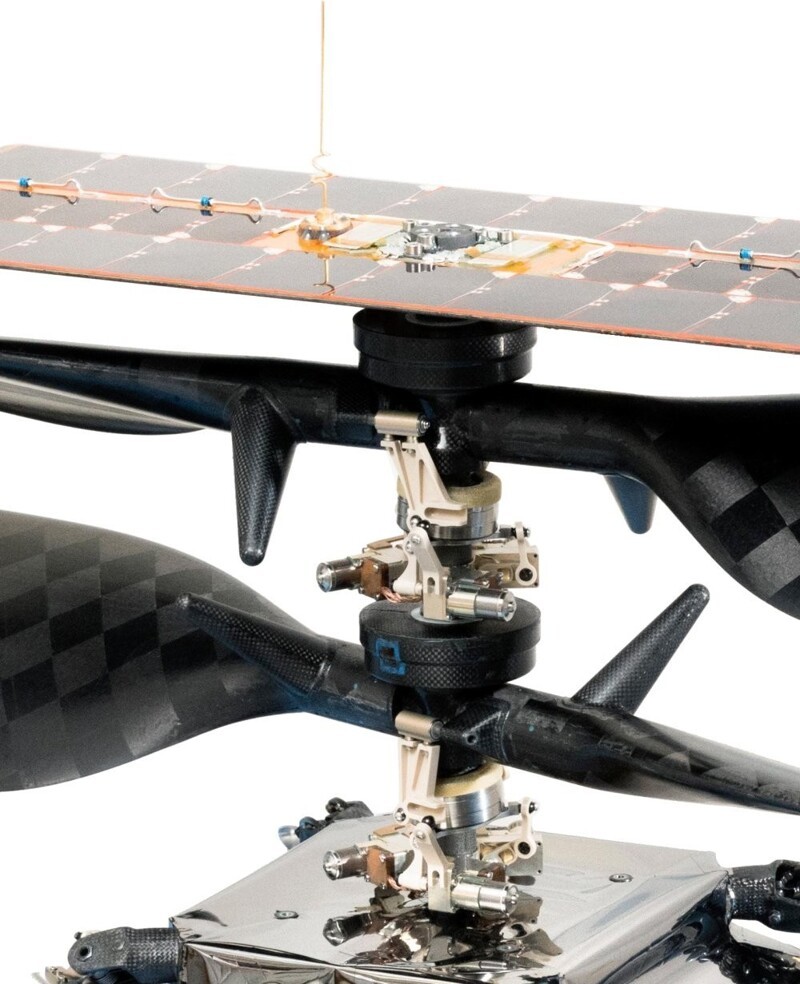
In addition, the helicopter had to operate in special conditions: the average annual temperature on the surface of Mars is about –63 °C. Yes, from time to time the Sun warms up the local air to above-zero temperatures, but in order for electronics to withstand icy nights, heating must be provided. Finally, don't ignore the infamous dust storms that can reduce the efficiency of solar panels or simply clog moving parts with fine sand and dust. 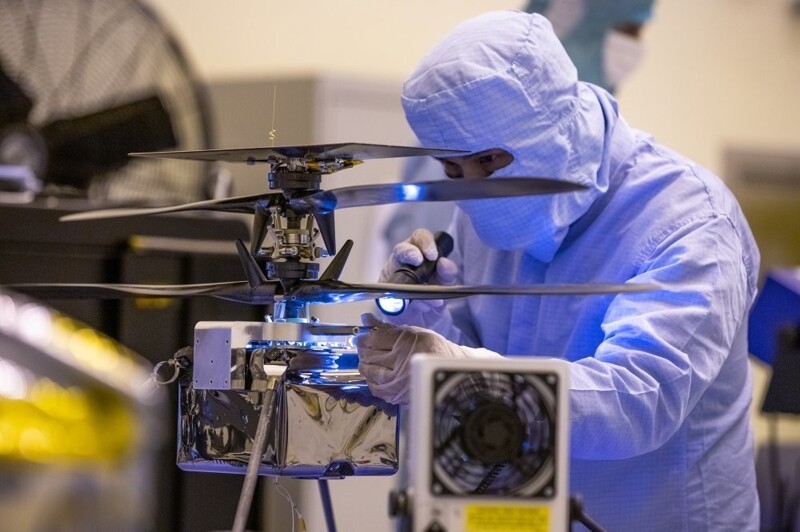
Each screw of the device is driven by its own “manual” electric motor. Thin copper wire of rectangular cross-section (for greater density) was wound onto the stator by special workers who controlled the process, monitoring the laying through a microscope.
So, the developers have created a device that, thanks to the rapid rotation of a pair of durable, balanced propellers, can fly low above Mars and is even ready to independently produce energy for itself. But for the flight to be successful, it must be controlled. And during ultra-high-speed rotation, the aerodynamic forces are too small compared to the inertia of the propellers themselves. Therefore, the entire system responds to control signals in a completely different way than conventional copters on Earth.
Typically, for Mars rovers and other interplanetary missions that must operate in conditions of increased radiation, American companies choose the RAD750, a radiation-resistant single-board computer based on the processor of the same name. However, this option turned out to be too bulky and heavy for Ingenuity.
NASA decided to use a block of five printed circuit boards connected into a cube instead of one computer. Their areas of responsibility: management of on-board batteries, navigation and servos, telecommunications, power supply, flight control. At the same time, the boards are equipped with Snapdragon 801 and dual-core Hercules processors. As a result, in terms of total computing power, the small Ingenuity helicopter significantly surpassed the heavy Perseverance rovers. 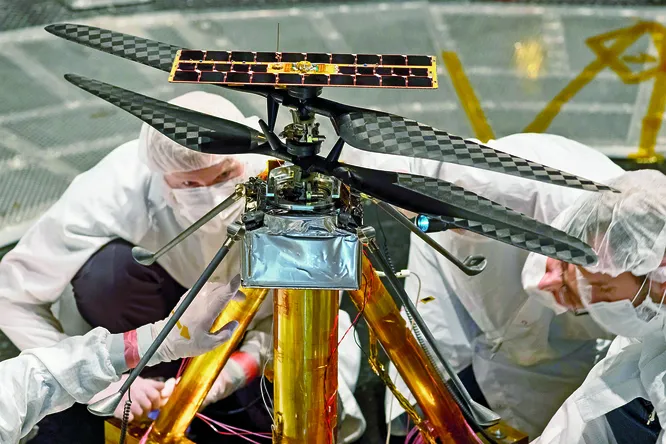
The energy for heating the control unit came from a solar panel through lithium-ion batteries. In the light they were recharged continuously, and at first this was enough. However, on the 427th sol (Martian day), when Ingenuity's operating life exceeded the planned one, the efficiency of the batteries decreased so much that the energy received was no longer enough to heat the entire night, especially since winter had come on the Red Planet. NASA specialists were able to quickly “reflash” the temperature control program, which allowed the helicopter to operate for hundreds of more sols.
Ingenuity launched to Mars along with the Perseverance rover in 2020. The flight lasted seven months, landing in February 2021 near the 50-kilometer Jezero crater (apparently, in ancient times it was filled with water, so scientists are extremely interested in this area). After traveling a short distance, the rover chose a convenient location and unloaded the drone. During the flight, he was under the bottom of the rover. 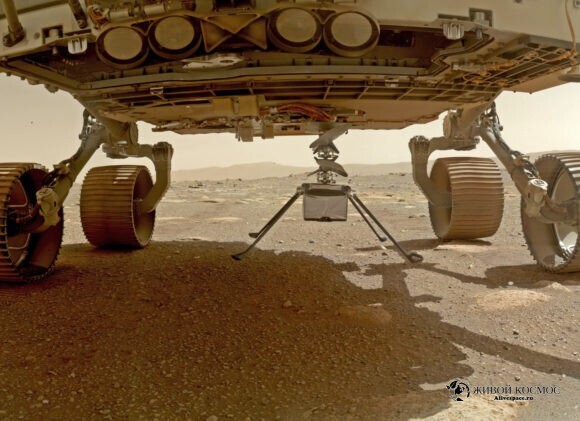
April 19, 2021 became a historic day for humanity. At 19:34 UTC, Ingenuity made its first powered flight on another world. It lasted 39.1 seconds, and during it the helicopter rose 3 meters, and the rotation speed of its blades exceeded 2500 revolutions per minute.
The helicopter took off and landed again at the take-off point, which received the symbolic name “Wright Brothers Field”. Then it took off more than 70 times - and this was with the planned five. 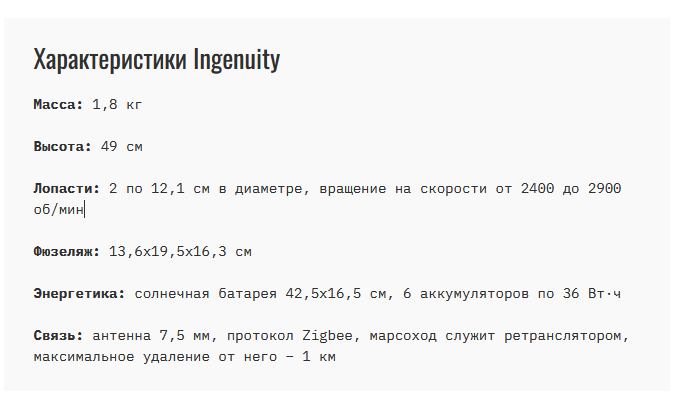
Ingenuity's first four flights took off and landed at the same point. But already during the fourth flight, Ingenuity moved horizontally 266 meters forward and flew back.
On its fifth flight, which took place on May 7, Ingenuity landed for the first time at a point different from its takeoff point. This flight completed the stage of demonstrating the technological feasibility of using such aircraft in the Martian atmosphere. 
Sandy area. Image taken during the 70th flight on December 22, 2023.
Ingenuity flew higher, further and faster, but never moved further than a kilometer from the rover to maintain constant communication with it, since the intrepid helicopter itself cannot directly communicate with the Earth or Martian orbiters.
Ingenuity navigated its own agenda, sometimes ahead of Perseverance, sometimes following it, and on several occasions demonstrated its extreme value as an excellent observer, analyzing the terrain the rover would traverse.
On January 18, mission leaders decided to make another short jump lasting half a minute with a climb of 12 meters without horizontal displacement to check the status of the systems.
Ingenuity took off on its 72nd flight and, having reached an altitude of 12 meters, remained motionless in the same position for 4.5 seconds before descending at a speed of 3.6 km/h. Unfortunately, at this stage the navigation system became disorientated again. And, most likely, she performed an evasive maneuver, believing that she was moving horizontally relative to the ground, although in fact her horizontal speed was zero.
As a result, the helicopter tilted and one of its blades collided with the ground, which led to its damage. 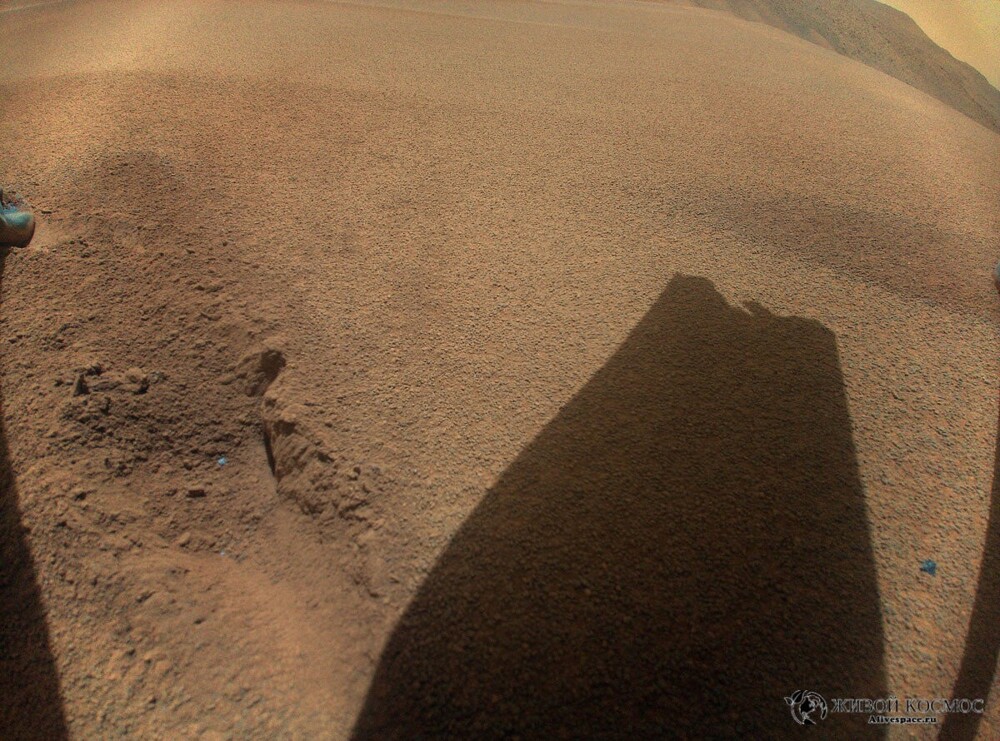
Shadow from a damaged blade.
What do we have in the end? The Mars helicopter "Ingenuity" made 72 flights in the skies of the Red Planet, covering a distance of 17 kilometers. In total, he remained in the air for more than two hours, 128.8 minutes to be exact. The robot reached a maximum height of 24 meters and a maximum speed of 36 km/h. 
The Perseverance rover (top left) on the rim of Belva Crater, photographed by Ingenuity from an altitude of 12 meters, taken April 22, 2023 (Sol 772). The helicopter's shadow can be seen in the center of the image.
Surviving this long on Mars is also a huge success. Thanks to the success of Ingenuity, NASA decided to include two helicopters in the MSR (Mars Sample Return) program, the purpose of which will be to deliver samples of Martian soil to Earth. 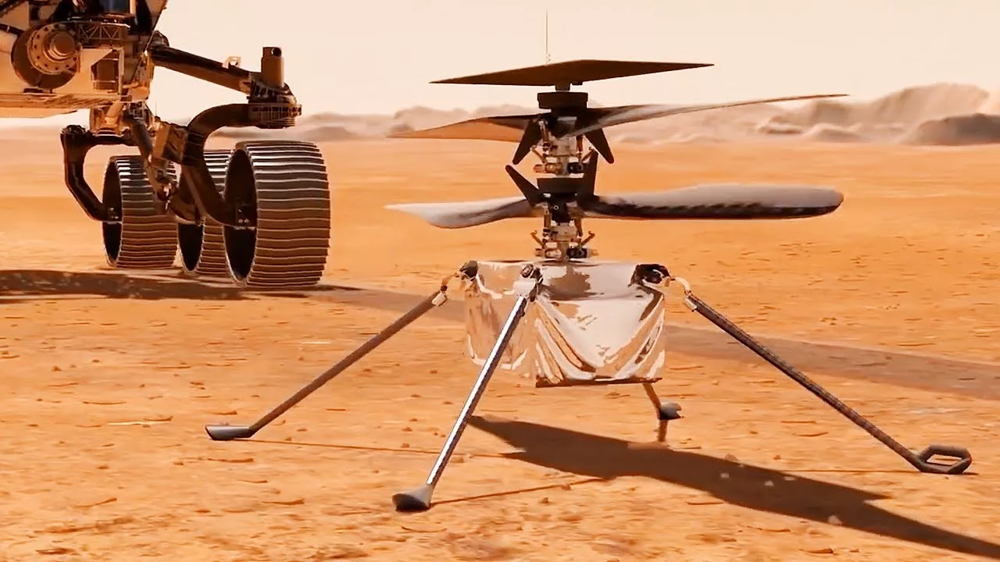
Add your comment
You might be interested in:










